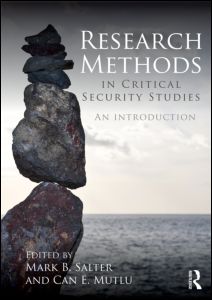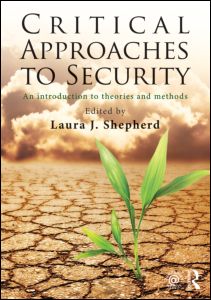2013 has so far been a great year for anyone interested in critical approaches to security. With the launch of the new journal, Critical Studies on Security, and two new edited collections on the theory and methods of critical approaches, it is a good time for anyone who shares some kind of dissatisfaction with mainstream approaches and wants to study or research security from a critical perspective.
Research Methods in Critical Security Studies: An Introduction
 Mark B Salter and Can E Mutlu’s book Research Methods in Critical Security Studies: An Introduction is motivated by “a desire to champion clear research design and rigorous method in critical security studies” (p.1). Consisting of thirty four chapters by thirty three authors it is clear from the outset that this book covers a broad range of approaches to research methods from a critical perspective. This diversity reflects the fact that there is no single Critical Security Studies (CSS) method, something which can be unnerving for students and incomprehensible even for some scholars[i]. Although Research Methods in Critical Security Studies covers such a wide-ranging set of approaches to research methods, Salter and Mutlu have collected the chapters in to six sections which help guide the reader by grouping chapters into conceptual areas.
Mark B Salter and Can E Mutlu’s book Research Methods in Critical Security Studies: An Introduction is motivated by “a desire to champion clear research design and rigorous method in critical security studies” (p.1). Consisting of thirty four chapters by thirty three authors it is clear from the outset that this book covers a broad range of approaches to research methods from a critical perspective. This diversity reflects the fact that there is no single Critical Security Studies (CSS) method, something which can be unnerving for students and incomprehensible even for some scholars[i]. Although Research Methods in Critical Security Studies covers such a wide-ranging set of approaches to research methods, Salter and Mutlu have collected the chapters in to six sections which help guide the reader by grouping chapters into conceptual areas.
The first section of the book focuses on research design, and is perhaps the most universally useful part of the book. In the first chapter Mark Salter provides a concise introduction to research design from an interpretivist perspective, focusing on the principles of clarity, fit and reflexivity (p.15-24). This chapter comes with an extremely handy CSS research design checklist which will be useful to all levels of researcher; from undergraduates beginning their dissertations to senior academics writing papers and books for publication.
Other contributors in the opening section address the issues of wondering (p.25-28), criticality (p.29-32) and empiricism without positivism (p.42-45). Within this section are three other chapters that focus on issues that are sometimes ignored in methods textbooks. A chapter by Anne-Marie D’Aoust, on the emotional and material factors of actually having what it takes to do research (p.33-36), brings to light the often overlooked, but incredibly real issues that impact on how research within CSS, and also in IR more broadly, is conducted. Taken together, this introductory section not only frames the rest of Research Methods in Critical Security Studies but it also provides a great introductory platform for researchers to begin their research on security from a critical perspective.
The rest of the book is divided into sections that are organised around conceptual ‘turns’ within social sciences and CSS; ethnographic, practice, discursive, corporeal and material. In each section each methodological turn is given an introduction and then scholars whose work is associated with each turn talk about their research. In each chapter, authors address their research design in relation to their research question, methods, results and also the challenges they have faced whilst doing research. Accounts from acclaimed scholars such as Claudia Aradau, Luis Lobo-Guerrero and David Grondin sit well alongside work from up and coming PhD researchers within CSS.
Each chapter is only a few pages long and this brevity is perhaps the only downfall of Research Methods in Critical Security Studies. This is a minor annoyance rather than an actual problem, purely because most of the chapters provide such interesting accounts of research that as a reader you are often left wanting more! Further readings that are recommended at the end of each chapter go some way to addressing this issue, as does engaging with the actual published work of each author.
It is hard to take away an exact methodological framework from Research Methods in Critical Security Studies that is going to fit your own research ‘like a glove’. However, this is hardly surprising in a field like CSS where one can be interviewing sex workers at 2am in a Cuban nightclub as Megan Daigle has done (p.81), attending airport security management courses like Mark Salter (p.107) or looking at parliamentary archives in relation to counter-terrorism laws as Andrew Neal does (p.125). This diversity of original and interesting work within CSS is clearly highlighted in the book and it is extremely unlikely that one text book alone is ever going to provide you with clear answers to one’s own methodological problems, simply because there is no singular CSS method or methodology. Rather, there is a broad range of interesting methods and methodologies that suit the critical inquiry of security.
In this regard Research Methods in Critical Security Studies works well as a source of inspiration for readers interested in CSS as it not only shows how diverse the field is, but celebrates it as well. Moreover, it does exactly what it says on the tin by providing an introduction to research methods within CSS that students and scholars of every level should find interesting and useful.
Critical Approaches to Security: An Introduction to Theories and Methods
 Critical Approaches to Security: An Introduction to Theories and Methods by Laura J Shepherd is the second recent edited collection on the topic of critical approaches to security. Eschewing the moniker of CSS, Critical Approaches to Security collects together a variety of theoretical approaches and methodological techniques in two sections on theory and method.
Critical Approaches to Security: An Introduction to Theories and Methods by Laura J Shepherd is the second recent edited collection on the topic of critical approaches to security. Eschewing the moniker of CSS, Critical Approaches to Security collects together a variety of theoretical approaches and methodological techniques in two sections on theory and method.
Each chapter comes with a summary and learning outcomes section up front and is closed with questions for further debate and sources for reading and research. This, coupled with figures, images and break away boxes within most chapters, makes for a clear and lively read that will keep undergraduate readers engaged whilst dealing with complex topics such as Foucault’s key ideas (p.82) and the ‘anti-method’ of deconstruction (p.214).
The first half of the book explores various critical theories of security, providing a useful overview of each theory that helps the reader in understanding how different packages of ideas shape how security is understood and how theory in turn informs methodological choices.
The second half of Critical Approaches to Security addresses methods and how one can go about collecting and analysing data. Many of the chapters compliment and provide a more in-depth engagement with the methods explored in Research Methods in Critical Security Studies. For example if one is interested in ethnography, Cai Wilkinson’s chapter in Critical Approaches to Security (p.129-145) provides an engaging and detailed account of ethnographic methods whilst the section on the ethnographic turn in Research Methods in Critical Security Studies (p.51-84) highlights how these methods work in a variety of scenarios and research projects. This example is just one that emphasises that reading Critical Approaches to Security together with Research Methods in Critical Security Studies is the best way to make the most out of the two edited collections.
Critical Approaches to Security also includes two chapters on methods that are not touched upon in Research Methods in Critical Security. The inclusion of a chapter on what is often seen as ‘the Q word’ from a critical perspective; quantitative methods, enriches Critical Approaches to Security and goes some way to showing that the quantitative/qualitative divide is a false dichotomy (p.103-117). A further chapter by Cerwyn Moore and Chris Farrands on visual analysis is also a welcome addition that explores the ‘aesthetic turn’ in IR and security (p.223-235); a ‘turn’ that is not included in Research Methods in Critical Security.
As with Research Methods in Critical Security Studies, it is unlikely that you will be able to copy and paste what’s in Critical Approaches to Security on to your own work, but again this is because how you go about doing your research “is ultimately up to you, and there is no right answer” (p.8). What you will gain from Critical Approaches to Security is a clear introduction to several complex theories of security and a concise guide to how certain key research methods work in practice.
Conclusion
Both of these edited collections stand alone as great introductions to critical approaches to security that will be of interest to anyone who is remotely interested in these topics. For those of a critical disposition they will be a useful guide to studying or conducting research on security. For those who take a more traditional approach to the study of security, these two books will, at the very least highlight that the theories, methodologies and methods of critical approaches work extremely well in helping to understand the historic and contemporary dynamics of security broadly defined.
The strength of Critical Approaches to Security is in its depth and detail on critical theories, methodologies and methods. Together with Research Methods in Critical Security Studies, whose strength lies in its account of many different methods in the context of actual research practice, one is provided with a firm foundation for studying and researching security critically. Both books build upon other introductory CSS texts[ii], providing a more detailed account of critical methodologies and methods. As such both books are a welcome addition to a sub field of security studies that is seemingly no longer at the margins.
—
Rhys Crilley is a PhD doctoral researcher at the University of Birmingham. His work draws upon critical approaches to security and focuses on images and narratives of conflict on social media platforms. He blogs at rhyscrilley.tumblr.com and can be followed on twitter @rhyscrilley.
[i] See Keith Krause’s 1998 article in Cooperation and Conflict on this topic. And although not in response to the lack of a CSS research program, see J.A Tickner’s 2005 article in ISQ to get an idea of how mainstream scholars fail to grasp the complexities of critical approaches with multiple ‘research programs’, methodologies and methods.
[ii] Other notable introductory texts to the critical study/research of security include seminal books by Ken Booth, Keith Krause and Michael C Williams. More recent introductory books on the topic include those by Karin Fierke and by Columba Peoples and Nick Vaughan-Williams.
Further Reading on E-International Relations
- Student Feature – Spotlight on The United Nations Security Council
- Review – Security as Politics: Beyond the State of Exception
- Review – Security Entrepreneurs: Performing Protection in Post-Cold War Europe
- Interview – Natalie Jester
- International Security
- Student Feature – Theory in Action: Feminism and Peacekeeping